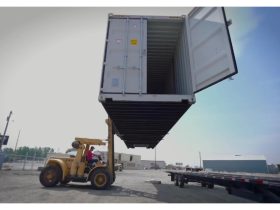If you’ve ever walked past a construction site and wondered, “Are these barriers actually doing anything?” — you’re not alone.
With all the drilling, hammering, and heavy machinery going on, it might seem impossible for a wall of fabric or panels to make a real difference. But here’s the thing: construction sound barriers aren’t just for show. They’re designed to reduce noise, and when used correctly, they can be surprisingly effective.
What Are Construction Sound Barriers, Exactly?
Construction sound barriers (also called noise control barriers) are specially designed materials used to block, absorb, or deflect sound waves coming from construction activities.
They’re usually:
- Installed around the perimeter of a construction site
- Hung on temporary fencing, scaffolding, or hoarding systems
- Made from materials like vinyl, fibreglass, acoustic foam, or even mass-loaded barriers
You’ve probably seen them—they often look like large, heavy-duty tarps or panels draped over fences. But don’t let their simple appearance fool you. The tech behind them is all about managing sound energy.
So… Do They Really Work?
Short answer: Yes, they do.
But the degree of effectiveness depends on a few things:
1. The Type of Barrier Used
Not all barriers are created equal. High-performance sound barriers use layers of sound-absorbing material and are engineered to reduce noise by 10 to 30 decibels (dB)—which is no small feat.
To give you an idea:
- A 10 dB reduction cuts the perceived loudness in half.
- A 20–30 dB reduction makes a massive difference, especially in dense urban areas where peace and quiet are rare.
2. How the Barrier Is Installed
It’s not just what you use—it’s how you use it.
Poorly installed barriers can leave gaps or be positioned too low or too far from the noise source. To work properly, sound barriers should:
- Be as tall as possible to block the line of sight to the noise
- Have no gaps at the bottom or sides
- Be positioned as close to the noise source as reasonably possible
3. The Type of Noise Being Produced
Some sounds are easier to control than others. For example:
- High-frequency noise (like cutting or grinding) is easier to absorb.
- Low-frequency noise (like engines or pile drivers) travels further and is harder to block completely.
Sound barriers can still reduce low-frequency noise, but the results may be more subtle compared to high-pitched sounds.
What Makes a Good Construction Sound Barrier?
If you’re a site manager, contractor, or even a nearby resident curious about what works best, here’s what to look for in an effective sound barrier:
High STC or SRI Rating
The Sound Transmission Class (STC) or Sound Reduction Index (SRI) tells you how well the material blocks sound. The higher the number, the better the performance.
Weather Resistance
Outdoor barriers need to withstand sun, rain, wind, and dust. Look for materials that are UV-resistant and waterproof.
Durability and Reusability
Good-quality barriers can be reused across multiple projects. They should be rugged and tear-resistant.
Fire Retardant
Safety is a must. Most high-grade barriers are flame-resistant and meet building standards.
Real-World Impact: What’s the Benefit?
Let’s say your site is producing about 90 dB of noise—about as loud as a lawnmower or a small motorbike.
Installing a good-quality sound barrier that reduces noise by 20 dB could bring that level down to 70 dB, closer to the sound of a vacuum cleaner or heavy traffic. That might not seem like a huge difference on paper, but in real life? It feels much quieter.
And it’s not just about comfort. Noise reduction has some real-world benefits:
Keeps neighbours happy
No one likes being woken up at 7 A. M by jackhammers. Barriers can help keep complaints down and maintain a good relationship with the surrounding community.
Meets noise regulations
Many cities have strict noise limits for construction. Using barriers can help you stay compliant and avoid fines.
Improves worker focus
Less noise means better communication, more concentration, and safer working conditions for your team.
Limitations to Keep in Mind
Of course, no solution is perfect. Sound barriers:
- Won’t eliminate noise completely—but they will reduce it significantly
- Need proper placement and maintenance to be effective
- Can be bulky or require planning during setup
But when compared to doing nothing at all? They’re one of the most cost-effective and practical tools available for noise control.
Final Thoughts: Are Sound Barriers Worth It?
Absolutely, when used the right way.
Construction sound barriers can’t make the site completely silent, but they can:
- Tone down harsh or disruptive noise
- Help you meet regulations
- Keep the peace with the public
- Create a more manageable working environment
So next time you walk past a construction site and see those big panels on the fence, know that they’re not just there for show—they’re actively working to make things a little quieter for everyone.







